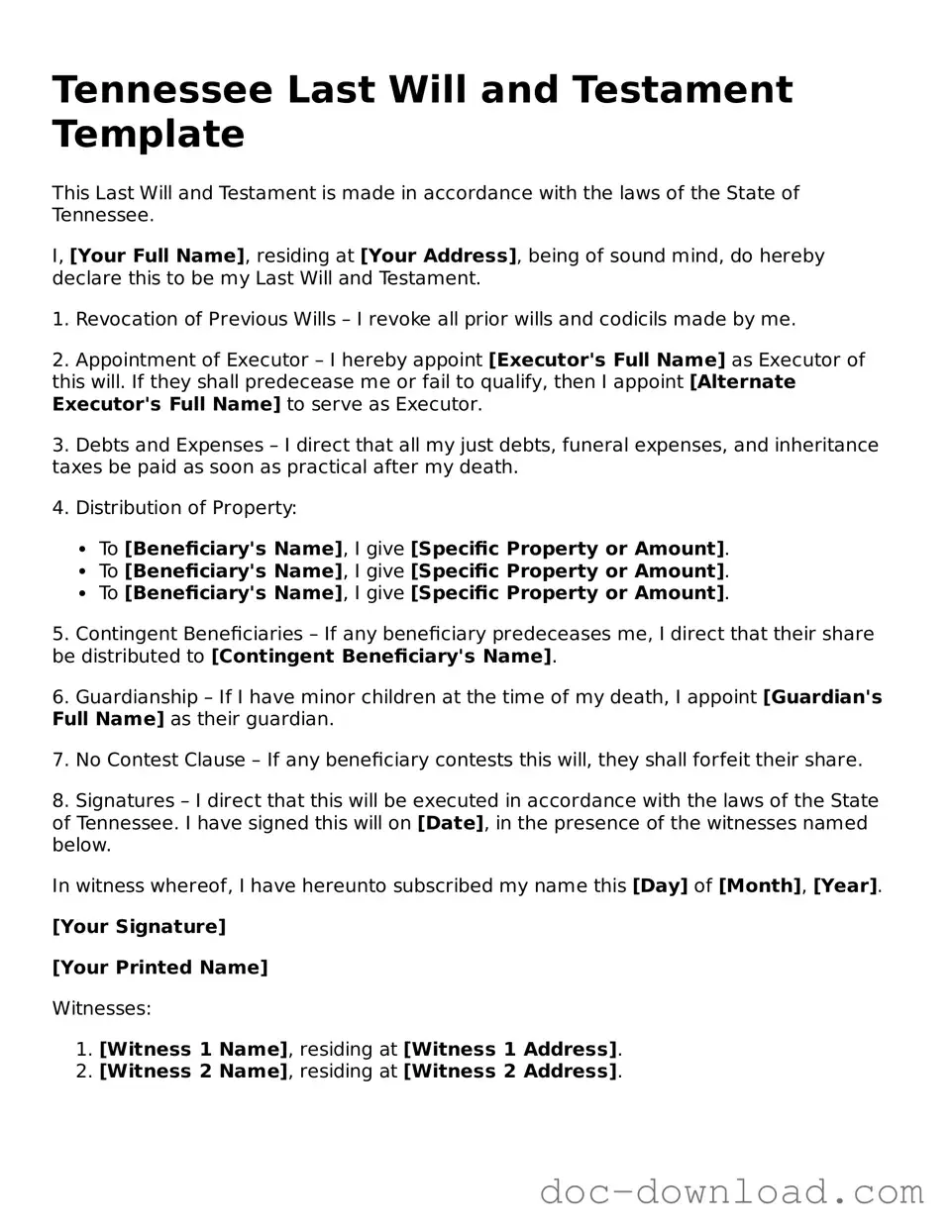The Tennessee Last Will and Testament form is similar to a Living Will, which outlines an individual's preferences for medical treatment in situations where they are unable to communicate their wishes. While a Last Will deals with the distribution of assets after death, a Living Will focuses on healthcare decisions during life. Both documents serve to protect an individual’s desires, but they apply to different circumstances—one for after death and the other for critical health situations.
Another document akin to the Last Will is the Durable Power of Attorney. This legal document allows an individual to designate someone else to make financial or medical decisions on their behalf if they become incapacitated. Like a Last Will, it ensures that a person's wishes are respected. However, while a Last Will only takes effect after death, a Durable Power of Attorney can be activated during a person’s lifetime, providing a layer of protection when they are unable to act for themselves.
In the realm of legal documentation, understanding the nuances of various forms is crucial. For instance, a Colorado Non-disclosure Agreement form serves as a vital tool, ensuring sensitive information remains confidential between parties in various dealings. By utilizing this agreement, individuals and businesses can protect their interests effectively. For those seeking more information about drafting important legal documents, resources such as Colorado PDF Forms can provide valuable templates and guidance.
The Revocable Trust is also similar to a Last Will, as it allows individuals to manage their assets during their lifetime and dictate how those assets will be distributed after their death. Unlike a Last Will, a Revocable Trust can help avoid probate, making the transfer of assets smoother and more private. Both documents aim to fulfill the grantor's wishes, but the Revocable Trust offers flexibility and control during life as well as after death.
A Healthcare Proxy is another document that shares similarities with a Last Will. This form designates an individual to make medical decisions on someone’s behalf when they cannot do so themselves. While a Last Will addresses asset distribution, a Healthcare Proxy focuses solely on health care preferences. Both documents are essential for ensuring that an individual's choices are honored, albeit in different aspects of life.
The Codicil is closely related to a Last Will, as it serves as an amendment to an existing will. This document allows individuals to make changes to their will without having to draft an entirely new one. Codicils can update beneficiaries, change asset distributions, or modify other provisions. Thus, while it retains the original will’s structure, it provides a means for flexibility and adaptation to changing circumstances.
Another important document is the Letter of Instruction. This informal yet valuable document provides guidance to loved ones regarding personal wishes, funeral arrangements, and asset distribution. While not legally binding like a Last Will, it complements the will by offering additional context and personal touches. It helps ensure that an individual’s preferences are clear and respected, bridging the gap between formal legal documents and personal desires.
The Affidavit of Heirship is also related to the Last Will, particularly in situations where someone dies without a will. This document helps establish the legal heirs of a deceased person, providing a way to transfer property when a will is not present. It serves as a means to clarify inheritance rights and can be crucial in the absence of a Last Will, ensuring that assets are distributed according to state laws.
The Prenuptial Agreement can also be compared to a Last Will in terms of asset protection. While a Last Will dictates the distribution of assets after death, a Prenuptial Agreement outlines how assets will be managed during marriage and in the event of a divorce. Both documents are vital for protecting individual interests and ensuring that personal wishes are honored, albeit in different life stages.
Lastly, the Trust Declaration, similar to a Last Will, creates a legal arrangement where a trustee holds and manages assets for the benefit of beneficiaries. This document can take effect during the grantor's lifetime or after death, providing a means to control asset distribution. Both the Trust Declaration and Last Will aim to fulfill the grantor's intentions, though the former offers more ongoing management of assets.
